Jul 24, 2010
Is Prince Charles ill-advised, or merely idiotic?
By James Delingpole
I do wish the Prince of Wales weren’t such a terrible prat because then I wouldn’t have to say it in print and quite ruin my chances of a knighthood. But he is a prat. A dangerous prat at that - as he reminded us yet again just the other day in a speech he gave to ‘business leaders’ at St James’s Palace about what he thinks is happening with ‘climate change’.
He said: ‘It has been profoundly depressing to witness the way the so-called climate sceptics are apparently able to intimidate all sorts of people from adopting the precautionary measures necessary to avert environmental collapse. For too long we have treated the planet like a perpetual cash machine which doles out money without there ever being any need to check the bank balance. But now finally the money is running out.’
There are so many idiocies, false assumptions, inversions of the truth and malevolent yearnings in just that one paragraph that I’m not sure where to begin. The phrase ‘so-called climate sceptics’, for example. What exactly is the Prince suggesting that the rational, decent empiricists who oppose global climate change alarmism ought to be called instead? Is ‘deniers’ perhaps the word he’s straining for? Or would he prefer something a little more robust? Untermenschen, maybe.
And these ‘all sorts of people’ who have been intimidated, surely he can’t mean those corrupt, mendacious, bullying scientists who were exposed in the Climategate emails breaching FOI laws, fantasising about beating up their opponents, conspiring to smear scientists who disagreed with them and to close down journals which published their work. Sounds like those thugs are quite capable of looking after themselves, not to mention their generous grant funding.
The ones being intimidated, surely, are the very ones opposing those ‘precautionary’ measures - on the not unreasonable grounds that the scientific evidence for the need to introduce them remains piteously thin. So oughtn’t they be the ones that the Prince of Wales sticks up for: the courageous seekers-after-truth who have sacrificed career advancement and easy funding for the greater good of science and mankind?
But perhaps the dodgiest bit of all is this assertion that there’s going to be an ‘environmental collapse’. Says who and on what evidence? If it’s catastrophic and unprecedented Anthropogenic Global Warming he’s talking about, well, the case remains entirely unproven. ‘Global warming’ stopped happening in 1998, so that effectively scuppers the argument about man-made CO2 being to blame. The widely recognised existence of the Medieval Warm Period scuppers the ‘unprecedented’ part. And the ‘catastrophic’ bit exists only in the wild imaginations of computer modellers whose ‘projections’ have about as much connection with observed reality as Prince Charles’s biofuel-powered Aston Martin does with the average family four-door saloon.
Quite a few of my friends are friends of the Prince of Wales and whenever I try pointing out what a poisonous loon he is they inevitably rise loyally to his defence, the usual line being that he is a fundamentally decent fellow who just happens to surround himself with ‘yes men’, because he’s a bit of a spoilt brat, and with sinister gurus whose advice he takes far too seriously because he’s not all that intellectually capable of independent thought.
I can believe all this. Like Aethelred the ‘Unready’ before him, Charles’s problem is that he is unread - ill-advised. But does this nuance make any material difference to the case against him? Hardly. Whether the Prince of Wales acts idiotically under his own steam or whether he does so as the puppet of his sinister gurus is really neither here nor there. What matters is the damage the man is capable of doing.
And unfortunately because of who he is and what he represents that potential damage is considerable. Would any of those ‘business leaders’ have turned up to listen to a speech in Croydon civic centre by a semi-employed, polo-playing, butter-dodging eco-freak with a crappy 2.2 degree in anthropology, archeology and history? Nah. But make the venue St James’’s Palace and that speaker the future King of England (and ‘Defender of Faith’, wretched dhimmi that he is) and suddenly all those brown-tongued corporate rats can’t get up that putrescent drainpipe quick enough.
Why am I having to say this stuff? WHY? It’s not like I’m a violent republican or anything. Au contraire, my fervent belief in the monarchy is one of the few ideological bones of contention I have with, say, Mick Hume or Claire Fox. They think the Queen should go. I think she’s one of the best things ever: decent, principled, stoical, kind, wise, dignified, the living embodiment of everything that was or is great about Britain, and a vital bulwark against the almost unimaginable horror that some men do call, in appalled whispers, ‘President Tony Blair’.
But one of the many reasons why the Queen is such a great Queen is that she understands the meaning of ‘constitutional monarchy’. We all have a rough idea of the splendid and enduring British values which she stands for - writing thank-you letters, cooked breakfasts, cherishing the old empire, being allowed to ride on your own land without some bothersome safety Nazi insisting you wear a hard-hat, etc - but because she never states her views explicitly she never runs into controversy or risks alienating those whose views are diametrically opposed to hers. This makes her the perfect unifying figurehead.
Her dismal heir, on the other hand, seems determined to rule over us like 1649 never happened, sowing division and contention among his subjects before his reign has even begun with his shrill, half-baked views on everything from modern architecture and GM food to homeopathic medicine and climate change. Some of these opinions you may agree with, but then even a stopped clock tells the right time twice a day. And the point, anyway, is that we shouldn’t be placed in a position where we have to take a view on what Prince Charles thinks. (Or what his sinister puppet masters tell him to think he thinks.) He’s supposed to be above creating such petty factionalism. Did his Cambridge tutors not explain to him why it was that we cut off his Mk I predecessor’s head?
I might have a scintilla more respect for Prince Charles’s, er, bold, refreshing outspokenness if he were to subject his ill-digested opinions to the crucible of open debate. But of course he never would because he’s way too grand and because anyway he’d get eaten alive. I’ll explain exactly why he’d get eaten alive in a future column. Suffice to say that the kind of neo-Malthusianism to which Prince Charles has become prey — no doubt with much input from deep green fanatics like the Hon Sir Jonathon ‘Wormtongue’ Porritt, who may or may not have written that truly appalling St James’s Palace speech - appears terribly convincing on the level of gut feeling but is entirely confounded by the last 2,000 years of history.
No, it is not climate change sceptics who, as Charles would have it, are playing ‘Russian roulette with the future of our children’. The real danger are those neo-Malthusian loons who, on no scientific basis, are planning to deny our children the economic growth which would bring them jobs, security, material comfort and happiness. Yes, ‘Sir’, as I believe I’m meant to call you. I mean you, you great princely prat!
Jul 23, 2010
Renewable energy: Not all it’s cracked up to be?
A recent bit of news from Scottish and Southern Energy (SSE) suggests that James Lovelock, the scientist behind the Gaia theory of Earth and its life systems, might have a point when he criticises most renewable energy sources as inefficient at best and foolish at worst.
In its latest interim management statement, issued this week, SSE reported that “weather conditions” during April, May and June contributed to a full 30 per cent drop in electricity output from its wind farms, hydroelectric facilities and Slough biomass heat and power plant. Output from those sources fell to 700 gigawatt-hours during that period, compared to the 1,000 gigawatt-hours generated during the last quarter of 2009.

While SSE didn’t elaborate on those “weather conditions,” one factor certainly had to be the fact that the first half of 2010 saw the “driest first six months of the year for 100 years,” according to the UK’s Met Office. And, as the climate continues changing, Britain can expect that type of situation to become more common, the agency warns. Icecap Note: Last two summers were cold and wet and last winter coldest since 1962/63 in Scotland, since 1977/78 in England. But that was all, we were told, weather not climate
If hydroelectric power sources are threatened by climate change, wind energy’s greatest shortcoming is its great variability, Lovelock warns in his latest book, The Vanishing Face of Gaia:
“Used sensibly, in locations where the fickle nature of wind is no drawback, it is a valuable local resource, but Europe’s massive use of wind as a supplement to baseload electricity will probably be remembered as one of the great follies of the twenty-first century...,” he writes.
Lovelock argues the only clean energy sources that make sense for society are nuclear and solar thermal energy. All the rest aren’t viable without heavy injections of government subsidies and green cheerleading, he says.
Lovelock acknowledges he sometimes takes a bit of hyperbolic licence to make his points - as when he warned that global warming will lead to a die-off of billions of humans this century, resulting in only a “few breeding pairs of people” left in the Arctic. But does he have a point here? Is the bit of news from SSE a warning sign that we’d be better off by aggressively developing nuclear and concentrating solar power (such as that proposed in the Desertec project), and forgetting more intermittent clean-energy sources?
Jul 20, 2010
Premature chill in the Arctic?
By Anthony Watts
It is still quite cold in the Arctic, with below normal air temperatures and sea surface temperatures surrounding the ice pack between around 2-4C. Much of that has to do with meltwater. I’ve added this image to our new WUWT Sea Ice Page tonight.
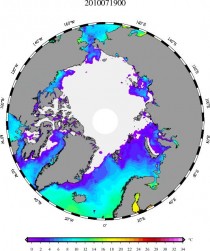
Source here.
But looking at another product from the Danish Meteorological Institute (DMI) there’s an indication of even colder temperatures, now hitting the freezing line in the middle of the Arctic summer.
While this most certainly could be a temporary blip, it seems the temperature in the arctic above 80N as calculated by DMI has steadily declined and hit 0C a bit early (just past midway) in the Arctic melt season.
See the graph below:

Source here.
Here’s the 3x magnified view of the top of the graph:
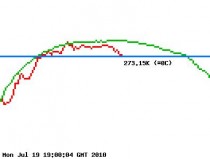
Much of the melt season so far has been below the green “normal climate” line. While it is just another data point (i.e. weather) , it is a curious and interesting development worth watching. The past few days melt has been accelerating, a bit, but with a dropping Arctic core temperature it would seem to suggest perhaps this is limited to some traditional melt zones for this time of year, such as near the Chukchi sea.
Look for more in WUWT Sea Ice News #15 this weekend.
See WUWT’s new sea ice page here. See Antarctic come close to 2007 record high below. Enlarged here.
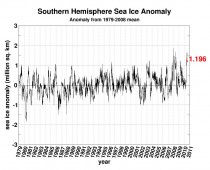
Jul 20, 2010
Does New Scientist foresee Paradigm Shift on Climate Theory?
By John O’Sullivan
With its frank ‘thumbs down’ to ‘whitewash’ inquiry into the Climategate scandal is international science magazine sensing a climate paradigm shift?
Popular international science magazine, New Scientist has appeared to give support to the claim that a recent official inquiry into the Climategate scandal may rightly be dismissed as a ‘whitewash.’ The change in tone from the usually emollient journal has some commentators foretelling a growing loss of faith in the science behind the global warming scandal.
Climategate caught media attention as it appeared to show damning revelations of alleged misconduct by a clique of researchers at the UK’s University of East Anglia’s Climate Research Unit (CRU) indicated by leaked emails in November 2009.
The clique were accused of fudging international temperature data to make the late 20th century appear to be an era of dangerous human-induced global warming. Subsequently, three official British inquiries have each exonerated the CRU of any wrongdoing.
Under the heading, ‘Without candour, we can’t trust climate science,’ (July 14, 2010), the weekly science magazine that reports on science and technology news for an international English-speaking audience, rebukes the most recent of those three official Climategate inquiries, that of Sir Muir Russell.
Most pointedly, New Scientist (NS) accuses the Muir Russell Inquiry of failing to answer the question: “How can we know whether CRU researchers were properly exercising their judgment?”
‘Hardcore Doubt’ About Climategate Inquiry Outcome
The London-based publication accuses Sir Muir Russell of a “failure to investigate whether emails were deleted to prevent their release under freedom of information laws.” Such a failure, they argue “makes it harder to accept Russel’s conclusion that the “rigour and honesty” of the scientists concerned “are not in doubt."”
Aussie Skeptic Attacks Climate Data Fraud
Climate skeptic, Malcolm Roberts, mounts a lucid rebuttal of the man-made global warming theory in his publication, ‘Two Dead Elephants in Parliament.’ Quick to pick up on the significance of New Scientist’s apparent move away from a posture sympathetic to established views, climate science blog, WattsUpwithThat ( WUWT), publishes its own take (July 19, 2010) commenting, “...we have the New Scientist, shocking warmists and skeptics alike with some hardcore doubt about the outcome of the Muir-Russell and other Climategate inquiries.”
The London-based publication is regarded as the most widely read news journal for scientists with seperate U.S. and Australian editions as well as a British version that has weekly sales of 170,000.
In its anonymous editorial NS adds, “But what happened to intellectual candour - especially in conceding the shortcomings of these inquiries and discussing the way that science is done. Without candour, public trust in climate science cannot be restored, nor should it be.”
Russell Inquiry ‘Left Stones Unturned’
The editorial accuses Sir Muir Russell’s team of leaving “stones unturned.”
The inquiry is also scolded for deciding against any detailed analysis of all the 1,000+ emails leaked onto the blogosphere in November 2009. Indeed, NS points out the Russell Inquiry examined only “three instances of possible abuse of peer review, and just two cases when CRU researchers may have abused their roles as authors of IPCC reports.”
In pulling no punches the inquiry is condemned for not having studied any of the hundreds of thousands more unpublished emails not leaked from the CRU Internet servers. The NS laments, “Surely openness would require their release.”
New Scientist: the ‘Ideas Magazine’
When accused in 2006 by science fiction writer Greg Egan of possessing “a sensationalist bent and a lack of basic knowledge by its writers” the magazine’s then editor, Jeremy Webb, was quickly on the defensive describing NS as “an ideas magazine - that means writing about hypotheses as well as theories.”
As may be seen by the reaction to the editorial, some observers perceive a ‘first step’ towards a paradigm shift away the global warming theory by the staff of NS. The greenhouse gas theory has been the subject of several high profile refutations in recent months by self-proclaimed ‘denier,’ Alan Siddons and other eminent international climate researchers.
Aside from the commentary of former meterologist and climate analyst, Anthony Watts at WUWT, other climate skeptic blogs have given a curt reaction. Bishop Hill appending the following NS quote, “Without candour, public trust in climate science cannot be restored, nor should it be,” with a solitary: “Yup.”
While another respected climate analyst, Canadian professor, Ross McKitrick of the Department of Economics, University of Guelph, Ontario, in the National Post (July 17, 2010), points to the dubious claims that the Russell Inquiry panel was ‘independent.’
McKitrick cites the fact that of the five panellists, one had to resign after giving a radio interview exonerating the scientists before the investigation began. Another is the vice-president of BP, formerly in charge of Gulf of Mexico drilling, who could not possibly have devoted his attention to the CRU investigation and “The panellist who guided the inquiry was Geoffrey Boulton, who spent 18 years at the University in the department under investigation.”
With evident cynicism McKitrick also points out that the inquiry held no hearings, only interviewed the clique of accused scientists and declined to consult any critics.
References:
Bishop Hill.com ,’New Scientist on Russell,’ (July 18, 2010), accessed: July 20, 2010.
McKitrick, R., ‘Global warming skepticism well justified,’ (July 17, 2010), National Post, (accessed online: July 20, 2010).
New Scientist, ‘Without candour, we can’t trust climate science,’ (July 14, 2010), Magazine issue 2769, (accessed online July 20, 2010).
WattsUpWithThat.com, ‘Bonus Quote of the Week: The New Scientist rocks our world,’ ( July, 19, 2010), accessed: July 20, 2010.
Read more at Suite101: Does New Scientist foresee Paradigm Shift on Climate Theory?
Jul 18, 2010
NOAA’s Jan-Jun 2010 Warmest Ever: Missing Data, False Impressions
By Anthony Watts
From Alan at Appinsys, who emails that he was inspired by this story on WUWT: A spot check on NOAA’s “hottest so far” presser
“NOAA: June, April to June, and Year-to-Date Global Temperatures are Warmest on Record”
The following figure from NOAA shows the temperature anomaly of January - June 2010 compared to the 1971-2000 base period for 5x5 degree grids.
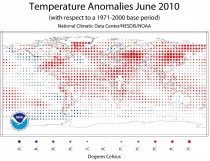
The problem with the above map: data quality and data manipulation.
The following sections provide some spot checks on the areas of the world exhibiting the most warming according to NOAA. The gridded historical data graphs shown in these sections are from the Hadley CRUTEM3 database for January - June. (CRUTEM3 uses a 1961-1990 base period whereas the NOAA data above is for a 1971-2000 base period. This simply shifts the anomalies on the vertical scale, but does not affect the relative trends.)
It is clear from the following sections that NOAA performs manipulations to create false impressions from the data, including assigning temperature increases were there is zero data.
Spot Check - Northern Africa
It is apparently much hotter than usual in the Sahara. But where is the data? Several of the 5x5 degree grids have zero stations (indicated by the black arrows). Many of the others have one station with very limited historical data. There seems to be an inverse correlation between the number of stations and warming - more stations in a 5x5 degree grid and less warming is observed.
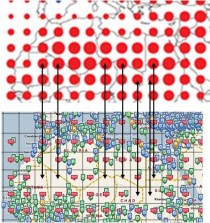
The map figure above shows the location of stations in the NOAA GHCN database (blue G or green B icons) and the red 5x5 icon indicates whether data exists in the Hadley CRUTEM3 database - a 5x5 degree gridded database used by IPCC (plotted here). The grid lines are 5×5 degree grids.
In many of the 5x5 degree grids showing 4 degrees warming according to the NOAA map, there are only one or two stations. The figure below shows some of the “hot-spots” in the NOAA map displaying January - June average temperature anomaly from the Hadley CRUTEM3 database for 1900 - 2009. In no cases is the warming close to what NOAA indicates.

There is a severe problem with lack of historical data in Africa as well as lack of coverage and gaps in the data. NOAA’s algorithms spread the low quality data across areas that have no data as well as showing warming that isn’t really there.
One must really question the NOAA data when even the areas with many stations seem misrepresented. The following figure shows the area of eastern Turkey which has many stations and shows no warming in Jan-Jun through 2009, but suddenly according to NOAA has 4 degrees in 2010.
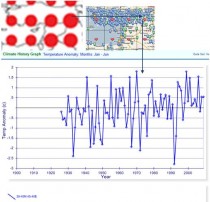
Spot Check - Greenland
It is apparently much hotter than usual in Greenland. But where is the data? Most of the 5x5 degree grids have zero stations (only some of which are indicated by the black arrows). Most of the grids with data have one station. The two hottest spots on the NOAA Greenland area show 5 degrees warming and have no data.
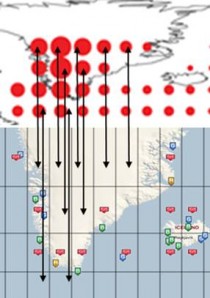
Some of the Greenland stations have long-term data. The figure below shows some of the “hot-spots” (that actually have data) in the NOAA map displaying January - June average temperature anomaly from the Hadley CRUTEM3 database for 1900 - 2009.
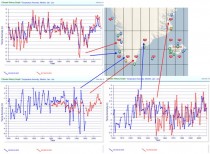
Spot Check - Canada
It is apparently much hotter than usual in Greenland. But where is the data? Most of the 5x5 degree grids have zero stations (only some of which are indicated by the black arrows). Most of the grids with data
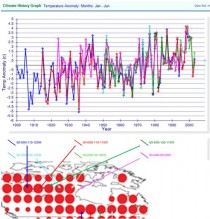
Read more and see full size images here.
-----------------
See Watts Up with that’s new sea ice tracking page here. See where the first part of July has seen the lowest ice melt of the last 8 years in the JAXA record here.
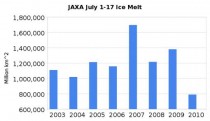
|















